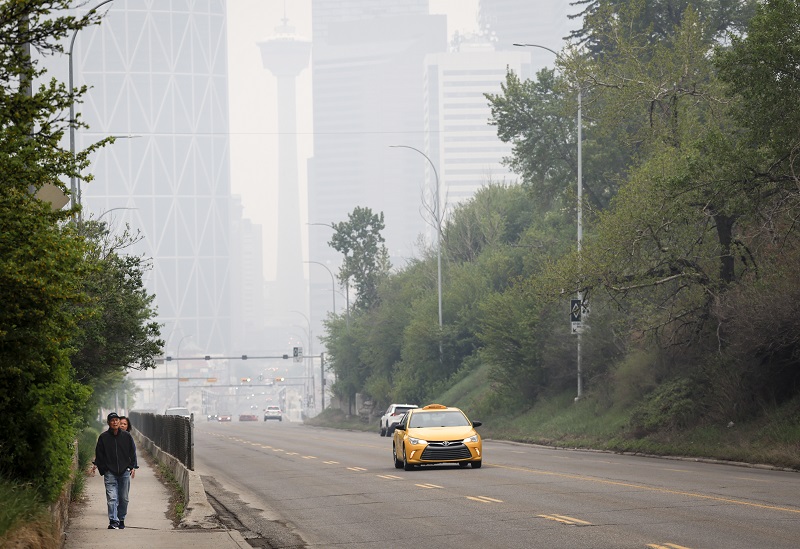Emissions from wildfires hit record high as climate change drives fire threat

OTTAWA – Emissions from wildfires hit a new record in 2021 as the blazes that raged in Western Canada and Ontario produced more greenhouse gases than the oil and gas sector and heavy industry combined.
Canada’s forests are relied on heavily to absorb the carbon dioxide we emit when we burn fossil fuels, but when those same forests burn, much of that trapped carbon gets released back into the air.
It’s a problem that is becoming more pronounced as climate change drives droughts, heat and increased lightning storms, which are a brutal combination for wildfires.
With a total estimated carbon footprint of 270 million tonnes, wildfire emissions were the single biggest source of greenhouse gases in 2021, equivalent to what would be emitted by 60 million cars over the course of a year.
But they were not included when Canada tallied its total emissions for the year, because wildfires aren’t considered to be directly under human control.
Michael Polanyi, a policy manager at Nature Canada, said the atmosphere does not distinguish between emissions from fires or those from fossil fuels.
“Definitely it’s concerning,” he said.
iStock.com/Toa55
Polanyi said Canada’s overall reporting of emissions from forests is a puzzle.
“On one hand, Canada’s kind of wanting to have its cake and eat it too,” Polanyi said.
“I mean, on one hand, they’re saying, ‘Well, you know, humans are not directly responsible for these massive wildfires, so we’re not going to count them in our total.’ But then they sort of claim that somehow, once trees regrow after wildfires hit, suddenly humans are responsible for that regrowth and we credit that.”
Polanyi said those emission credits are then tallied against emissions from harvesting forests, which makes it look like logging has a lower carbon footprint than it does.
Rebecca Hornbrook, an atmospheric chemist at the National Center for Atmospheric Research in Colorado, said wildfire emissions are in many ways part of the natural carbon cycle and shouldn’t be viewed the same way we see emissions from the burning of fossil fuels.
But she said the increased number of wildfires, and their growing intensity in a world affected by climate change, are cause for concern.
Hornbrook said the air pollution from wildfires is something everyone should be watching for.
She noted the major fires burning in Alberta are affecting air quality not just in the immediate vicinity, but even thousands of kilometres away in Eastern Canada and the United States.
Hornbrook said forest management practices appear to have reduced the total number of fires that hit each year, but climate change means the fires that do happen are often hotter, more intense and bigger.
In the 1990s, Canada averaged 8,400 fires a year, which burned an average of 324 hectares each.
In the 2000s, there were fewer fires annually, coming out to an average of 7,300 each year. These burned an average of 256 hectares.
Then, between 2010 and 2019, there were closer to 6,000 fires a year. But these burned 504 hectares each, on average.
The problem is more pronounced in some provinces than others.
In British Columbia, the average burned area grew from 14 hectares per fire in the 1990s to 237 hectares per fire in the 2010s. In Alberta, it was 123 hectares per fire in the 1990s, compared with 330 hectares per fire in the 2010s.
The increase in intensity is also causing more emissions.
Hornbrook said models to calculate emissions from a fire are based on factors including the density of a forest, its age, the kind of ground cover and the number of hectares burned.
In 1990, Canada recorded about 10,000 fires. They burned about 950,000 hectares and produced 30 million tonnes of carbon dioxide or its equivalent in methane and nitrous oxide.
In 2021, Canada recorded fewer fires – almost 6,600. But these burned 4.3 million hectares and produced more than five times more emissions. It amounted to 270 million tonnes of greenhouse gases.
Kate Lindsay, senior vice president at the Forest Products Association of Canada, said climate change has also meant forests are not getting as long to regrow between fires.
Lindsay said people who work in forest management are trying to learn from the data and guide their plans on where to log, in part so they can help take wood from areas that may be more immediately prone to fires, and reduce the fuel available there when a fire hits.
Feature image: Thick smoke from wildfires blankets the downtown for a second day in Calgary, Alta., Wednesday, May 17, 2023. The Alberta government says hot and dry conditions are expected to continue in the coming days, providing no relief for the roughly 2,500 people fighting wildfires in the province. THE CANADIAN PRESS/Jeff McIntosh







